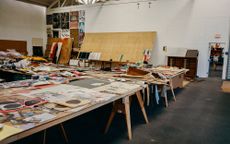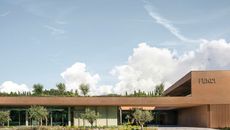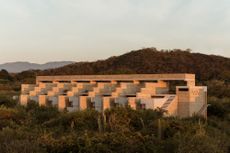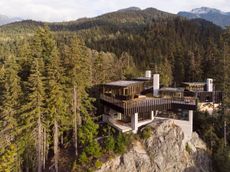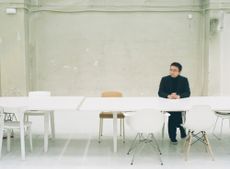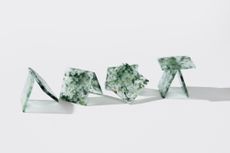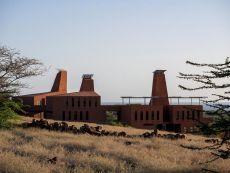Best Public Building, the shortlist: Wallpaper* Design Awards 2023
We reveal the shortlist for Best Public Building: Wallpaper* Design Awards 2023
- (opens in new tab)
- (opens in new tab)
- (opens in new tab)
- Sign up to our newsletter Newsletter
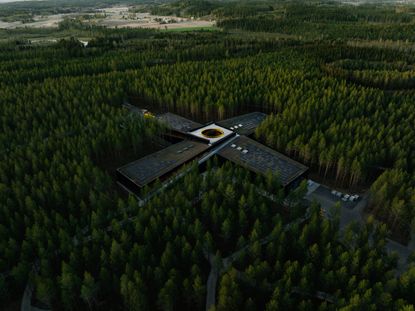
Welcome to the Best Public Building: Wallpaper* Design Awards 2023 shortlist. A university campus, a museum, a chapel, a gallery and a factory are battling it out for the coveted title. Scroll down for some of the year’s finest buildings.
The winner of this and all the Wallpaper* Design Awards 2023 will be revealed in the February issue of Wallpaper*, on sale 5 January, as well as here at Wallpaper.com.
THE SHORTLIST: BEST PUBLIC BUILDING: WALLPAPER* DESIGN AWARDS 2023
RCA campus, UK, by Herzog de Meuron

A robotic arm, quietly and relentlessly at work, may come into view as you walk around the new RCA Battersea campus in London. Its presence is the result of the freshly completed Royal College of Art Battersea Campus Building, which, designed by Herzog & de Meuron, has opened its doors for the university’s creative community. This visibility also emphasises the RCA's expansion, focus and transformation into a STEAM (science, technology, engineering, art and mathematics) postgraduate university, where subjects such as computer and materials science, robotics, advanced manufacturing and intelligent mobility are placed at the heart of the school.
Within this context, Herzog & de Meuron's relatively low, linear building feels like an ode to brick, featuring the Swiss duo and team's long-standing explorations in material, surface and texture. Clad mostly in brown blocks and glass and featuring hardwearing concrete floors, the new structure includes four storeys of studios and workshops (for art and design); The Hangar – a double-height, 350 sq m multifunctional activity space; a dedicated robotics space; a research and development section; a purpose-built home for the Helen Hamlyn Centre for Design; and a seminar and conference facility. The overall character seems industrial, utilitarian; this is a building conceived as a workshop.
Key features: open spaces, community emphasis, brick architecture
Architects' previous work: M+, Hong Kong; Elbe Philharmonic Hall, Germany; Tate Modern, UK
rca.ac.uk (opens in new tab)
herzogdemeuron.com (opens in new tab)
Chapel of Sound, China, by Open Architecture

Nestled in the green, rolling hills of Jinshanling, in the countryside north-east of Beijing, the Chapel of Sound cuts a sculptural, monolithic figure. The project, resembling something between giant land art and a natural rock formation is the brainchild of Chinese architecture studio Open Architecture. The practice, founded by Li Hu and Huang Wenjing, designed the building as an open-air concert hall, offering views to the ruins of the Ming Dynasty-era Great Wall of China, merging its strong, rippling concrete form with its context of greenery and historical architecture. Working with a fairly open brief, the architects described wanting the building to help them ‘see the shape of sound’.
The building has a brutalist, almost boulder-like appearance. The material is enriched by an aggregate of local mineral-rich rocks, connecting it physically as well as conceptually with its surroundings. This, the rock-like overall composition, and the fact that the volume was carved to be narrower towards the base (designed with the help of international engineering firm Arup), helped the architects ensure that the piece has a gentler impact in its natural surroundings. At the same time, using no heating or air-conditioning, the Chapel of Sound consumes minimal energy, in keeping with this sustainable approach.
Key features: concrete structure, brutalist architecture, open plan, flowing forms
Architects' previous work: Tank Shanghai; Sun Tower (in progress); Pingshan Performing Arts Center in Shenzhen; UCCA Dune Art Museum
openarch.com (opens in new tab)
Valley Gallery, Japan, Tadao Ando

Merging nature, art and architecture, Valley Gallery, the latest build by Tadao Ando on Naoshima, is the Pritzker Prize-winning architect’s most conceptual design to date. It marks 30 years since his first building on the island, the Benesse House Museum, which was Naoshima’s first art museum, as well as a hotel. Nestled in the base of a deep valley, the new gallery is a modest structure with an angular steel roof and a trapezoidal floor plan informed by the landscape. Ando aimed ‘to create an independent architectural space while preserving as much of the existing topography and trees as possible’, in order to make the most of the site’s potential.
Covering a total floor area of 96 sq m, Valley Gallery consists of a white-walled room within an external concrete shell. Both are housed under an angular 12mm steel-plate roof reminiscent of origami folds, and accentuated by two corner openings at 30 degrees, framing the outside sky and revealing seasonal changes – wind, rain, sunshine or snow. The interior uses only natural illumination, with the angled skylights casting shadows on the concrete walls throughout the day, forming sharp silhouettes akin to a sundial. Ando says: ‘As a means of creating such an architectural space as a microcosm, I came up with the scheme of a space as simple and pure as a white canvas [with] natural light entering into it. A void in which everything superfluous has been erased, coloured by light that shifts with time and the seasons.’
Key features: concrete architecture, minimalism, connections with the outdoors
Architects' previous work: Church of the Light; Row House in Sumiyoshi; Casa Wabi; 152 Elizabeth Street
benesse-artsite.jp (opens in new tab)
tadao-ando.com (opens in new tab)
‘The Plus’ Vestre factory, Norway, by BIG

When we met outdoor furniture manufacturer Vestre's then-CEO (and current Minister of Trade and Industry of Norway) Jan Christian Vestre about a year ago, he enthusiastically took us through his plans to create The Plus, 'the world's most sustainable factory'. Now, thanks to his efforts and with a design courtesy of Bjarke Ingels Group (BIG), the building site in the middle of a Norwegian forest we visited in 2021 is now a fully fledged production facility – and so much more. The Plus has opened in Norway's Magnor, inviting employees, clients and visitors to experience its sustainable architecture. ‘The Plus is a factory for the people! It is a project we have put an enormous amount of soul and energy into. This is an important day for us, but also for the Norwegian mainland industry and the Scandinavian export cooperation,' says Stefan Tjust, current CEO of Vestre.
Key features: sustainable architecture, timber structure, embedded in nature, green roof
Architects' previous work: Danish Maritime Museum; LEGO House; Audemars Piguet Museum; Kistefos Museum
big.dk (opens in new tab)
vestre.com (opens in new tab)
theplus.no (opens in new tab)
Bob Dylan Centre, USA, by Olson Kundig

The Bob Dylan Center was conceived as the ultimate destination for the study and appreciation of the famed musician and his worldwide cultural significance. Located in the Tulse Arts District and designed by Seattle-based architecture studio Olson Kundig, the building is now home to a collection of more than 100,000 items spanning nearly 60 years of Dylan’s career. The space was designed to be flexible and easy to adapt – as the architects' winning competition entry was centred on the notion of Bob Dylan as a 'Master of Change'. The design transformed a former paper warehouse into a contemporary exhibition space. The building's brick front facade features the interpretation of a 1965 photo by Jerry Schatzberg.
Key features: adaptive reuse, brick architecture, community themes
Architects' previous work: LeBron James Innovation Centre; The Cortland; Seattle Space Needle; children's museum at Jewish Museum Berlin
olsonkundig.com (opens in new tab)
Ellie Stathaki is the Architecture Editor at Wallpaper*. She trained as an architect at the Aristotle University of Thessaloniki in Greece and studied architectural history at the Bartlett in London. Now an established journalist, she has been a member of the Wallpaper* team since 2006, visiting buildings across the globe and interviewing leading architects such as Tadao Ando and Rem Koolhaas. Ellie has also taken part in judging panels, moderated events, curated shows and contributed in books, such as The Contemporary House (Thames & Hudson, 2018) and Glenn Sestig Architecture Diary (2020).
-
 Portable lights to illuminate your winter nights
Portable lights to illuminate your winter nightsThe best portable lights and where to buy them: brighten up your winter evenings with this edit of portable lamps for your desk, garden and more
By Rosa Bertoli • Published
-
 Last chance to see: Sterling Ruby’s ‘Turbines’ at Gagosian New York, marked here by our visit to the artist’s LA studio
Last chance to see: Sterling Ruby’s ‘Turbines’ at Gagosian New York, marked here by our visit to the artist’s LA studioStep inside American artist Sterling Ruby’s studio, divided into distinct areas of operation
By Hunter Drohojowska-Philp • Published
-
 The Fendi factory in Tuscany disappears into the landscape
The Fendi factory in Tuscany disappears into the landscapeThe new Fendi Factory in Italy, set in the rolling hills of Tuscany, is the brainchild of Milan architecture studio Piuarch and the luxury brand
By Ellie Stathaki • Published
-
 Best Private House, the shortlist: Wallpaper* Design Awards 2023
Best Private House, the shortlist: Wallpaper* Design Awards 2023We reveal the five shortlisted homes competing for Best Private House: Wallpaper* Design Awards 2023
By Ellie Stathaki • Published
-
 Alberto Kalach and Grupo Habita’s Hotel Terrestre scoops Wallpaper* Design Award 2022
Alberto Kalach and Grupo Habita’s Hotel Terrestre scoops Wallpaper* Design Award 2022Featuring sustainable architecture, 360-degree vistas of sea, jungle and mountains, and a considered take on luxury, Puerto Escondido’s brand new Hotel Terrestre is Wallpaper’s Best Hotel for 2022
By Ellie Stathaki • Last updated
-
 The Rock by Gort Scott wins Best Private House: Wallpaper* Design Awards 2022
The Rock by Gort Scott wins Best Private House: Wallpaper* Design Awards 2022The Rock by Gort Scott scoops Best Private House at the Wallpaper* Design Awards 2022, selected from a shortlist spanning continents, settings, materials and approaches
By Ellie Stathaki • Last updated
-
 Sou Fujimoto judges Wallpaper* Design Awards 2022
Sou Fujimoto judges Wallpaper* Design Awards 2022We chat with Wallpaper* Design Awards 2022 judge Sou Fujimoto about his work in Japan and abroad, and our shortlisted designs and winners
By Jens Jensen • Last updated
-
 Glass tiles by Studio Plastique, Snøhetta and Fornace Brioni win Best Domestic Design: Wallpaper* Design Awards 2022
Glass tiles by Studio Plastique, Snøhetta and Fornace Brioni win Best Domestic Design: Wallpaper* Design Awards 2022Recycled glass tiles by Studio Plastique, Snøhetta and Fornace Brioni win Best Domestic Design in our Wallpaper* Design Awards 2022 – meet the winners and explore the shortlist
By Léa Teuscher • Last updated
-
 Francis Kéré’s Startup Lions ICT Center scoops Best Public Building: Wallpaper* Design Awards 2022
Francis Kéré’s Startup Lions ICT Center scoops Best Public Building: Wallpaper* Design Awards 2022Kéré Architecture’s Startup Lions ICT Center education campus is crowned Best Public Building at the Wallpaper* Design Award 2022, emerging as the winner from a shortlist that brings together culture and community in a rich array of nominations
By Ellie Stathaki • Last updated

